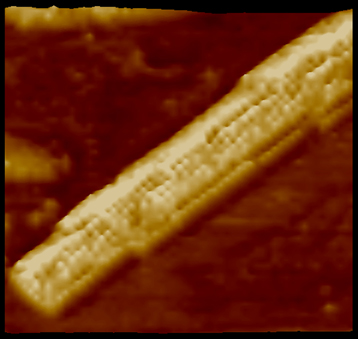Researchers from the French research institute CNRS and the University of Strasbourg succeeded in producing plastic fibers with high electrical conductivity that are only a few nanometers thick

Researchers from the French research institute CNRS and the University of Strasbourg have succeeded in producing plastic fibers with high electrical conductivity that are only a few nanometers thick. These fibers are formed by exposure to light or a flash of light. Being cheap and simple materials to manufacture, they combine the advantages of the two most common materials used today to conduct electricity: metals and plastic organic polymers. In fact, they are similar in their electrical conductivity property to metals.
In addition to being cheap and simple materials to manufacture, they are also light-weight and flexible like plastics - properties that pave the way for cracking one of the most important challenges in the field of electronics of the twenty-first century: the miniaturization of components to the nanometer scale. The research findings were published on the website of the scientific journal Nature Chemistry. The next step is to succeed and demonstrate that these fibers can be integrated on an industrial scale into electronic devices such as flexible displays, solar cells, transistors, etc.
In their previous research, the scientists were able to obtain nanowires for the first time ever. To do this, they chemically modified chemical molecules called "triarylamines" that have been used for decades in photocopiers. Much to their astonishment, they discovered that upon exposure to light and in the solution itself, the new molecules clumped together independently into orderly piles while obtaining tiny fibers.
In the next step, the researchers examined the electronic properties of the resulting nanofibers. They placed the molecules in contact with a micrometer electrical circuit that included gold electrodes about a hundred nanometers apart. In the next step, they applied an electric field between these electrodes.
The first important finding was that when the molecules are in solution and exposed to light they organize independently between the electrodes. The second surprising result was that these structures, light and flexible as plastic materials, were able to transmit a particularly high level of current, a level close to that found in metal wires. In addition, they have an extremely low resistance to metals, about ten thousandths less than the best organic polymers on the market today.

4 תגובות
Mr. Ben Ner:
I think the last, unclear sentence is a translation of this one:
"They have very low interface resistance with metals6: 10,000 times below that of the best organic polymers."
Yair:
If there were no amazing things, we wouldn't even need scientists to study them.
If your point is that scientists do not yet fully understand self organization – bingo! That's why we are studying it, and sharing what we discover in articles.
In each particular case of self organization the explanation is found a posteriori through simulations. What we would like is to find simpler yet more general principles.
Any analogy to a person who does not understand what just happened is valid.
Leder. Moshe Nachmani
please explain. What does the sentence in the penultimate line mean "...they have a particularly low resistance to metals..."
Thanks for your answer
The bottom line here - if I have understood correctly, oh layman like me - is that we are still in an era where
The biggest achievements in the nano field are materials, patterns or properties that are created by themselves
And indeed amaze the scientists.
But, between us, if the materials did not arrange themselves independently, the scientists would simply be left wanting
Onim, they wouldn't publish anything and to make matters worse - they wouldn't be surprised by anything.
Which is equivalent, say, to the primitive man eating a doe that was burned in a forest fire. He's not yet
A hunter, not a farmer and not even a cook. The roast meat just appeared on its own - to his astonishment.